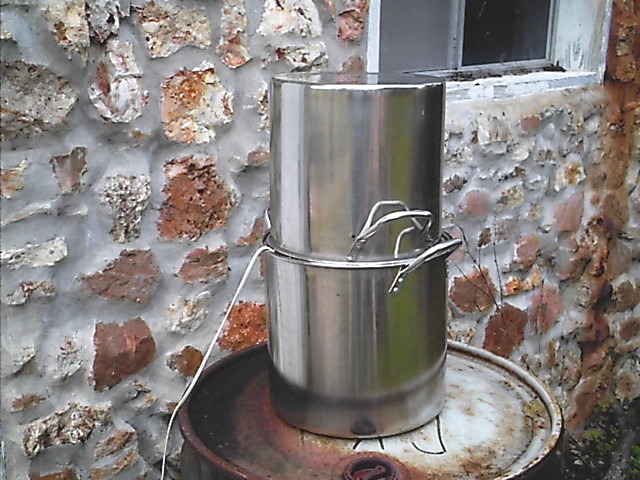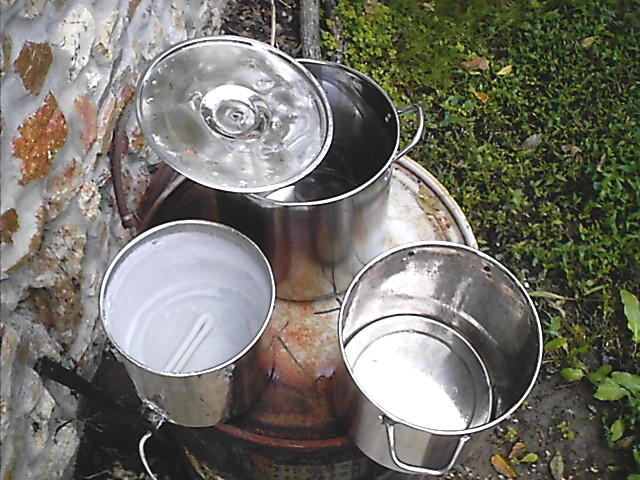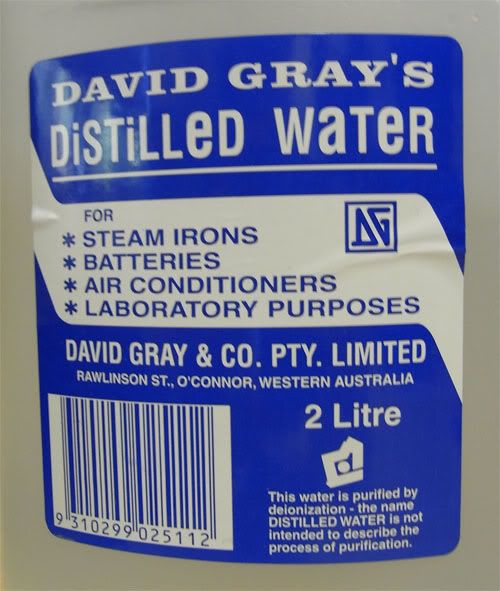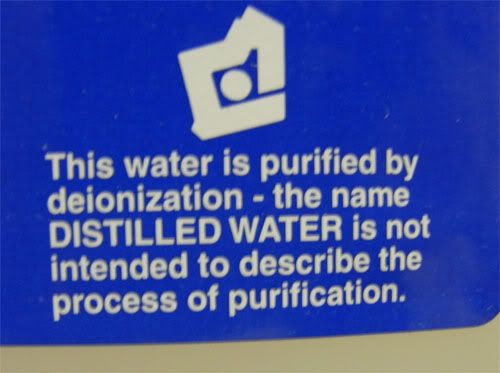Right post, wrong place? If covered before, delete.
I mulled over the water question pretty thoroughly before deciding distilled water was the way to go (for me, anyway). $ 0.88 a gallon at Wally-World, though. So how about making your own? But first, why distilled? Crud dissolved in water gets "plated" out in your boiler. that's why. Crud is called "dissolved solids", and the type and amount depends a lot on the water source. The other consideration is "Ph", which measures how "acidy" or not the water is. Acidy means the water will "eat" away your boiler, meaning acidic water corrodes metals. My chemistry books say "pure" water has a Ph number of 7.0, contains no dissolved solids, and is considered neutral, or neither acidic nor basic. Further, they say distillation produces pure water, so, I built a water distiller, since our well water is quite "hard", containing lots of dissolved limestone, an Ozarks typical material.
Happened that Wally-World had a sale going on with a set of 4 stainless cookpots, each of different size, that "nested" within one-another, so they came in one box large enough for the biggest one, the set being $17.00. Very good price. Made in China.
I squirreled away the biggest one to use for brewing beer (!), and did a little drill-twising, to remove the handles from the smallest one, reverse them on the middle one, and used the cover made for the big one, with a few small holes drilled in it, to support the small one, the middle-sized being turned upside-down to cover the small one, resting on the big cover sitting on the large pot. Maybe a pic will clarify:

I used an electric water heater element designed for 120-volts for heat, punched a hole through the side, at the bottom of the middle-sized pot, used a kitchen-sink drain pipe sealing washer to seal the element in the side of the pot, using a nut inside. The line cord can be seen protruding out from under the top pot's rim (upside down) in the first pic. Here's the mess all separated and sitting there waiting to work:

The dings on the cover are not really there, some kind of reflection, it's actually nice and flat, shiny, smooth. The boiling pot with element visible, can be seen to have quite a layer of white lime built-up in it. I scrape it out every 5 or 6 fills. As a footnote, the thing has made distilled water now for several years, and the element finally burned out. I found Wally sells a nice GE hotplate which fits perfectly in this system on top of the cover plate, eliminating the need for the hole and element. I pitched out the old boiling pot, and comandeered one of my wife's copper cookpots the right size; it now boils the water, sitting on top of the hotplate, which sits on top the cover plate, which.,...blah, blah, blah. Seriously, this thing works pretty nice! Be aware all, that distilled water is always exposed to surrounding air when not stoppered in a jug, and becomes slightly acidic by picking up CO2 from the air. This is compensated for by adding a high-Ph dissolvable chemical like sodium carbonate, lye (too dangerous), or even baking soda (not quite enough "oomph", but works).
Don't make one if you live in UK; it's against the law! Thanks fer lookin'!! jack
I mulled over the water question pretty thoroughly before deciding distilled water was the way to go (for me, anyway). $ 0.88 a gallon at Wally-World, though. So how about making your own? But first, why distilled? Crud dissolved in water gets "plated" out in your boiler. that's why. Crud is called "dissolved solids", and the type and amount depends a lot on the water source. The other consideration is "Ph", which measures how "acidy" or not the water is. Acidy means the water will "eat" away your boiler, meaning acidic water corrodes metals. My chemistry books say "pure" water has a Ph number of 7.0, contains no dissolved solids, and is considered neutral, or neither acidic nor basic. Further, they say distillation produces pure water, so, I built a water distiller, since our well water is quite "hard", containing lots of dissolved limestone, an Ozarks typical material.
Happened that Wally-World had a sale going on with a set of 4 stainless cookpots, each of different size, that "nested" within one-another, so they came in one box large enough for the biggest one, the set being $17.00. Very good price. Made in China.
I squirreled away the biggest one to use for brewing beer (!), and did a little drill-twising, to remove the handles from the smallest one, reverse them on the middle one, and used the cover made for the big one, with a few small holes drilled in it, to support the small one, the middle-sized being turned upside-down to cover the small one, resting on the big cover sitting on the large pot. Maybe a pic will clarify:

I used an electric water heater element designed for 120-volts for heat, punched a hole through the side, at the bottom of the middle-sized pot, used a kitchen-sink drain pipe sealing washer to seal the element in the side of the pot, using a nut inside. The line cord can be seen protruding out from under the top pot's rim (upside down) in the first pic. Here's the mess all separated and sitting there waiting to work:

The dings on the cover are not really there, some kind of reflection, it's actually nice and flat, shiny, smooth. The boiling pot with element visible, can be seen to have quite a layer of white lime built-up in it. I scrape it out every 5 or 6 fills. As a footnote, the thing has made distilled water now for several years, and the element finally burned out. I found Wally sells a nice GE hotplate which fits perfectly in this system on top of the cover plate, eliminating the need for the hole and element. I pitched out the old boiling pot, and comandeered one of my wife's copper cookpots the right size; it now boils the water, sitting on top of the hotplate, which sits on top the cover plate, which.,...blah, blah, blah. Seriously, this thing works pretty nice! Be aware all, that distilled water is always exposed to surrounding air when not stoppered in a jug, and becomes slightly acidic by picking up CO2 from the air. This is compensated for by adding a high-Ph dissolvable chemical like sodium carbonate, lye (too dangerous), or even baking soda (not quite enough "oomph", but works).
Don't make one if you live in UK; it's against the law! Thanks fer lookin'!! jack






